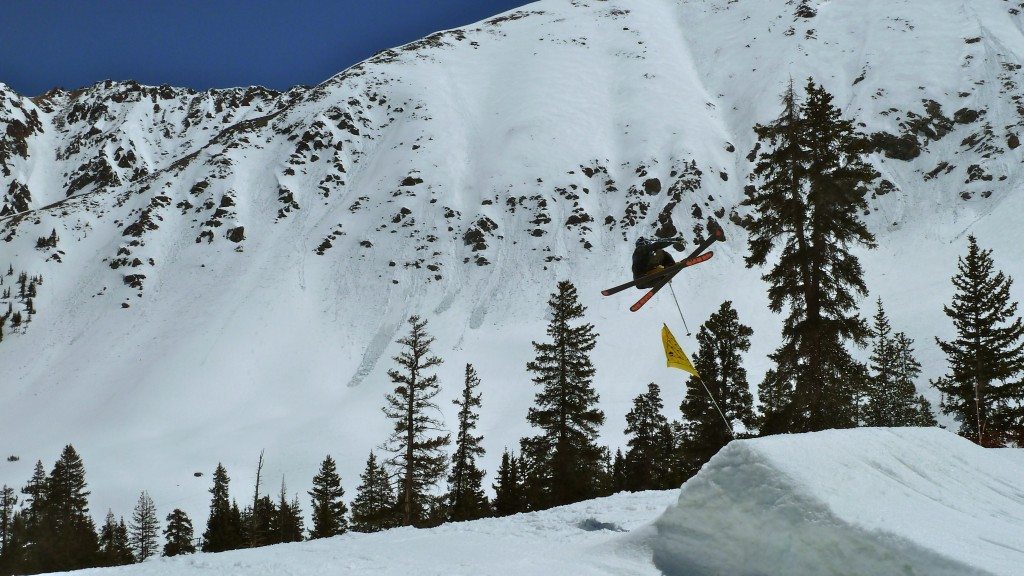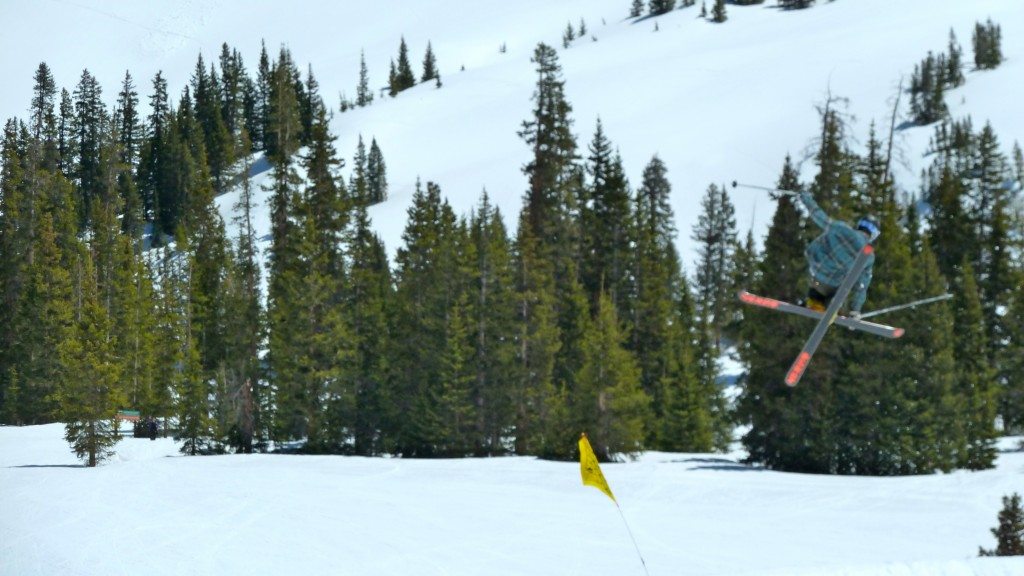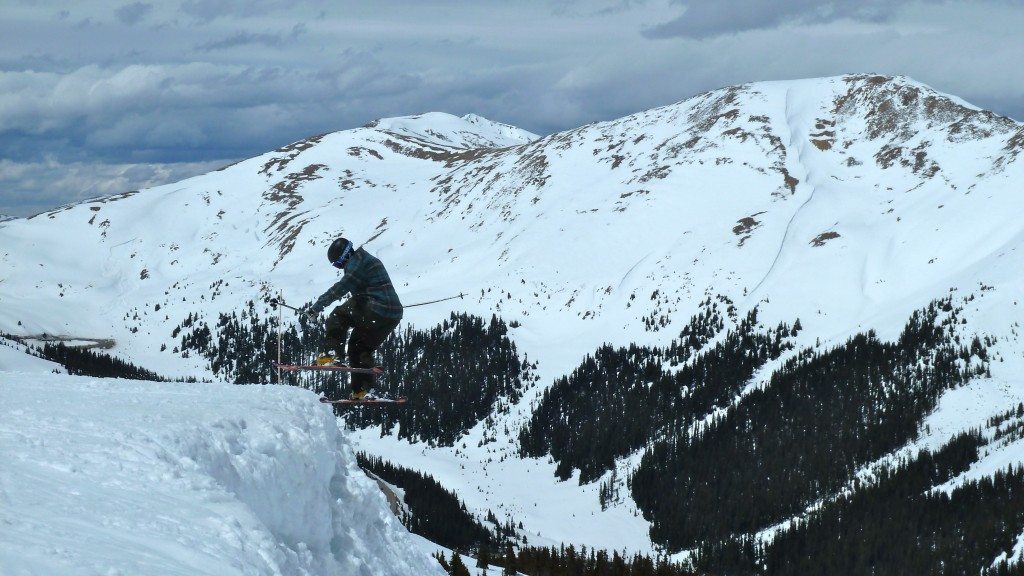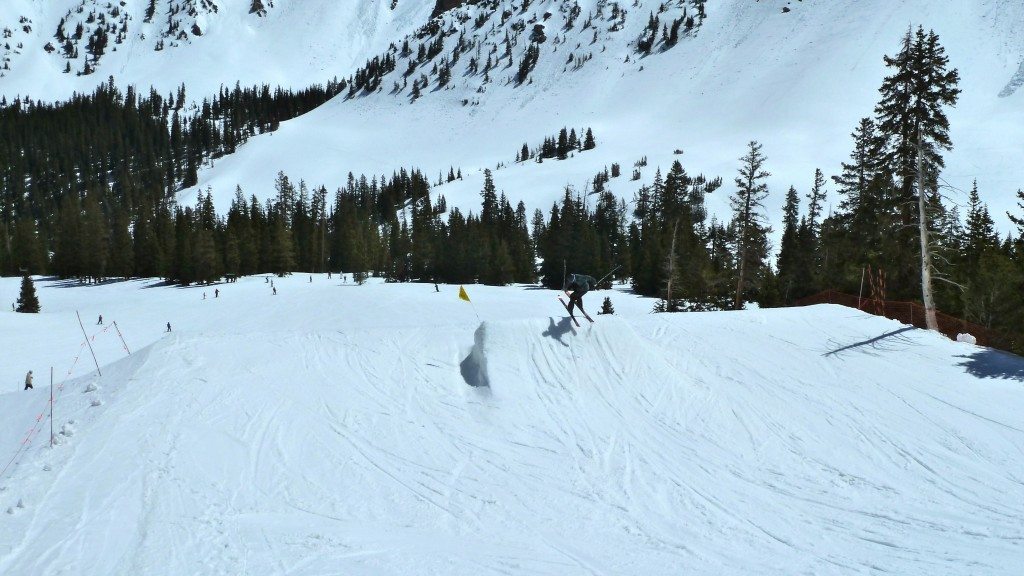Ski: 2011-2012 4FRNT Switchblade, 181cm 
Dimensions (mm): 122-89-116
Turn Radius: 18.4 meters
Actual Tip to Tail Length (straight tape pull): 179cm
Boots / Bindings: Nordica Supercharger Enforcer / 4FRNT demo, DIN at 10
Mount Location: -1cm from true center
Test Location: Arapahoe Basin
Days Skied: 2
Memorial Day weekend yielded beautiful, sunny weather at Arapahoe Basin. This was quite the change from all the snow A-Basin had been getting the last few weeks. Spring had finally arrived, just in time for A Basin’s biggest party of the year, the 10th Annual Festival of the Brewpubs. It was also the perfect time to test 4FRNT’s newest park ski. Good times!
Arapahoe Basin’s Treeline Park was in excellent condition for this time of the season. A blustery tailwind combatted the slushy conditions and allowed the jumps to stay open most of the weekend, allowing me to spend a couple of full days testing the Switchblade in its element.
For me, the Switchblade’s moderately stiff flex was pretty ideal for a park ski. Butters and presses were manageable, but did require a little bit of effort. Though stiff, the flex was consistent and predictable – there was no guesswork when setting presses of any kind. I frequently found myself skipping jumps and rails so I could jib their rollers. But while butters and nose blocks were a blast on the Switchblade, jumps were really where the ski shined.
The flex was particularly spot on for airs of all kinds. I never once was concerned about washing out on the tables in the Treeline Terrain Park or when sending it off King’s Cornice. The stiffer flex also helped the Switchblade cut through choppy off-piste landings and late afternoon landings in the park. A nimble turn radius and ability to hold an edge gave me confidence when approaching the lips of jumps. I’m not usually one to carve off of the lips of jumps, but it felt very natural on the Switchblade.

The “pop” of the Switchblade is pretty average, which isn’t surprising given its shallow camber (the skis are pretty much flat). But I didn’t find this characteristic to hurt the skis performance. If anything, the average pop combined with a stiff flex and solid edge hold made the Switchblade very predictable on jumps, and predictability is kinda nice when skiing fast into large features.
Despite being mounted with pretty heavy demo bindings, I found the Switchblade to have a fairly light swing weight; its semi-cap construction helps to keep the swing weight down. (It also reduces topsheet chipping, good news for those who sweat stuff like that).
Having broken my ankle back in October, I was still getting reacquainted with my old bag of tricks. I had no problems tossing 7’s, 9’s, and rodeos off the final, fairly small, jump in the park. The Switchblade gave me the confidence to throw all the old stuff as if I had never been hurt.

The Switchblade has an 88mm waist, which has become increasingly common in park skis these days. This extra width doesn’t affect the weight much and makes the ski more fun in a number of ways. In the park, added width adds stability on landings. It’s also nice on rails, and I felt more locked on and had more ski to play with. (I came to a similar conclusion when testing the Icelantic Da’Nollie, which is also 88mm underfoot.)

Furthermore, a wider park ski will generally work better all over the mountain, and the Switchblade performed really well outside of the park.
I was comfortable on the Switchblade in the many forms of slush I found. I had no trouble tackling slushy moguls, thick chop, and thicker, choppier chop (yeah, we skied a lot of slush). Even at high speeds, I felt in control. I could get forward and drive the Switchblade, or I could choose to maintain a more centered, upright stance. The ski was remarkably forgiving in these chunky conditions.
Despite a more traditional sidecut, the Switchblade rode just fine switch, both on and off the groomers. The snow on the groomers was significantly diced up from the start of each day of my test, yet I was still able to hold an edge and ski switch confidently on the Switchblade. I had no trouble avoiding racers, gapers, newbies, and the decked-out, awesomely costumed, party people on the slopes (it was Memorial Day weekend, after all).
Thanks to its stiffer flex, pulling off switch landings in heavier, off-piste chop was surprisingly easy, and riding and making turns in the thick snow was pretty manageable, too.

The Switchblade could hold a solid edge and also make shorter and slashy turns equally as well in the slush. I had a blast combining the two styles: running wide open then throwing the ski sideways on top of rollovers (not recommended when skiing shirtless).
Tight turns in trees and in moguls were also quite fun. A short turn radius and non-symmetrical tail made for easy turns down steep, fast zipper lines.
Scrubbing speed was also easy with the Switchblade, and as a result, I opted to ski most runs faster than I would on other park skis like the K2 Kung Fujas or the Icelantic Da’Nollie. For a ski billed specifically as 4FRNT’s flagship park ski, the Switchblade really killed all over the mountain.
Overall, I was quite impressed with 4FRNT’s Switchblade, and it wasn’t easy for the ski to win me over. First, I had recently tested the Icelantic Da’Nollie, one of the most fun park skis I have ever been on.
Second, I was initially unsure what to think about the Switchblade, since as a park ski it is not very unique: it has no symmetrical sidecut, no rocker, no fancy bells or whistles. But it turns out that 4FRNT didn’t need to slap any of these features on the Switchblade in order to build a bomber park ski.
The Switchblade’s smooth ride (and intergalactic graphics) made me feel like I was in charge of a space ship – free to travel at warp speeds, yet able to maneuver quickly and touch down with ease. Other would-be astronauts should give the Switchblade a look. This ski would be ideal for a park skier looking for one setup to do everything other than ski the deep. The Switchblade would also be a great addition to any quiver in need of a dedicated park ski that isn’t a noodle.


do you prefer this ski or the Da’nollie for the overall park, including 50-70 footers
Hi Jackson,
Overall I prefer the Da’Nollie as a park ski. I never spent a lot of time hitting 60+ ft jumps when I was skiing park fairly regularly. I tore my ACL last year and I haven’t been in the park since. So the more playful Da’Nollie would be one of my top choice for a park ski today. The Switchblade is still decently playful, but is better suited for hitting big jumps.
AG